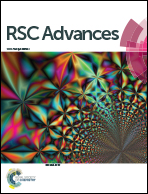Plasmonic photocatalyst Ag@AgCl/ZnSn(OH)6: synthesis, characterization and enhanced visible-light photocatalytic activity in the decomposition of dyes and phenol†
Abstract
An efficient visible-light-driven photocatalyst Ag@AgCl/ZnSn(OH)6 (Ag@AgCl/ZSH) was successfully fabricated by an ultrasonic assisted precipitation-photoreduction method at room temperature. The photophysical properties of the as-prepared samples were characterized by X-ray diffraction (XRD), Fourier transform infrared spectroscopy (FTIR), scanning electron microscopy (SEM), transmission electron microscopy (TEM), energy dispersive X-ray spectroscopy (EDX), UV-vis diffuse reflectance spectroscopy (DRS), X-ray photoelectron spectroscopy (XPS), and photoluminescence emission spectra (PL) analysis. The photocatalytic activities of the as-prepared samples were evaluated by the photodegradation of rhodamine B (RhB), crystal violet (CV) and phenol aqueous solution. The Ag@AgCl (8 wt%)/ZSH-20 composite exhibited the optimal photocatalytic performance, and the corresponding degradation rates for RhB, CV and phenol solution were as high as 22/3.6, 15/4 and 16/3.6 times those of pure ZSH and the conventional visible-light photocatalyst N–TiO2, respectively. The effect of photo-reduction time on the photocatalytic properties of the Ag@AgCl/ZSH composites was systematically investigated. Moreover, a possible degradation mechanism was proposed based on reaction equations and a simulated scheme on the basis of active species trapping experiments and band energy analysis. The dramatically enhanced photocatalytic performance of Ag@AgCl/ZSH should be ascribed to the surface plasmon resonance (SPR) effect from Ag@AgCl nanoparticles and high separation of photogenerated electron–hole pairs in the photocatalytic process, leading to low recombination rates of the photoinduced electron–hole pairs. High degradation efficiencies and physicochemical features were maintained after five recycling experiments, indicating that the photocatalysts were relatively durable and stable. It is expected that the plasmonic photocatalyst Ag@AgCl/ZSH is a promising candidate material for the photodegradation of organic pollutants in wastewater.


 Please wait while we load your content...
Please wait while we load your content...